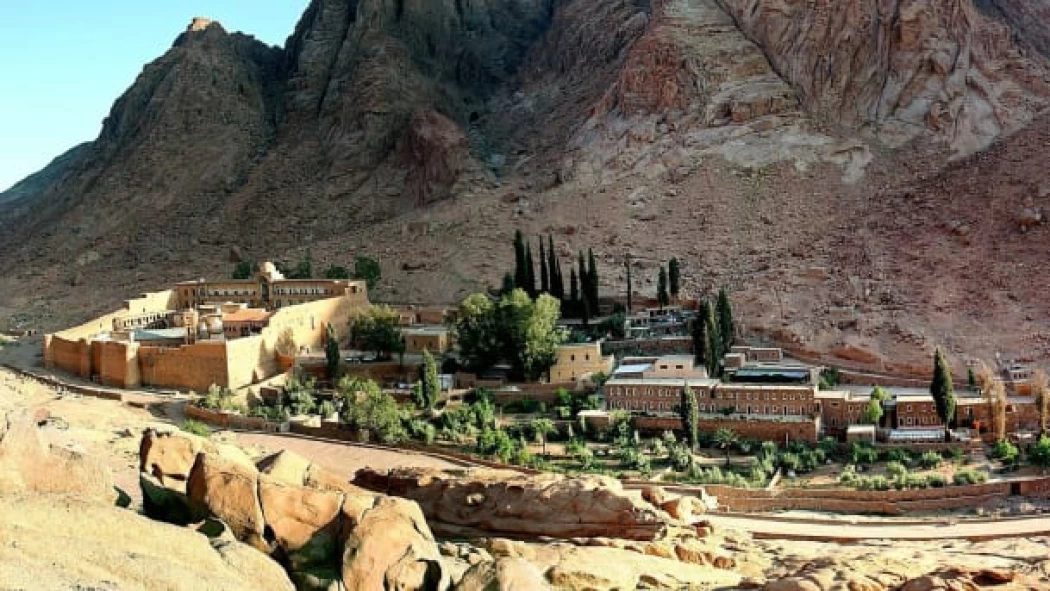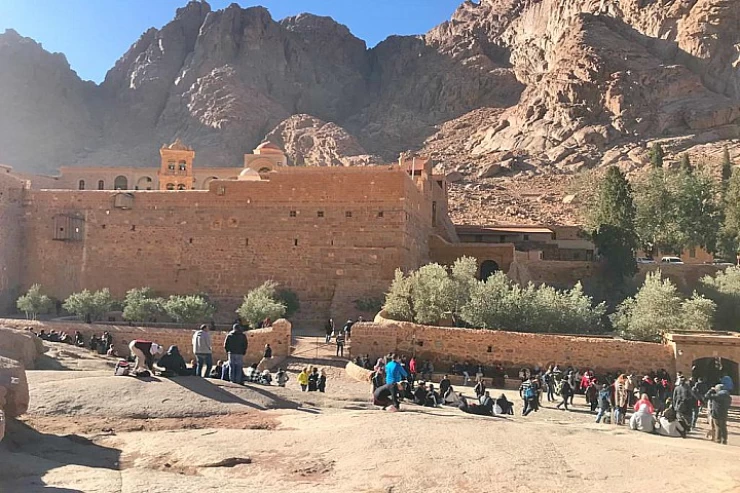
Saint Catherine Monastery
The Saint Catherine Monastery was established in 527 A.D. by the Emperor on the site of a chapel built by the Emperor's capital of Montana in 337 A.D., where tradition holds that Moses encountered the burning bush and received divine communication. St. Catherine, who was martyred in Alexandria during the fourth century, is said to have endured torture on the wheel, been beheaded, and subsequently taken away by angels. The monastery acquired its name in the tenth century when monks claimed to have discovered her incorrupt body on Mount Saint Catherine, the highest peak in Egypt, standing at 2,642 meters. Nestled among towering red granite mountains, the monastery has remained largely secluded for many years. Historically, pilgrims faced a long and arduous journey to reach it; however, a well-maintained road now connects it to various coastal cities, allowing for daily visits by numerous individuals. As a result, the small village of Saint Catherine is often bustling with tourist buses, particularly in the morning hours. The surrounding mountains are renowned for their striking beauty, and it is common for visitors to hike up Mount Sinai to take in the views of the site where, according to tradition, Moses received the Ten Commandments. Within the fortified complex, the sixth-century church is adorned with stone columns, surrounded by grand marble pillars, and its walls are embellished with gilded icons and paintings. At the eastern end of the church, above the altar, lies one of the most exquisite artistic treasures, a sixth-century mosaic depicting the Transfiguration, although it may be challenging to view it due to the presence of chandeliers and painted icons. To the left and below the altar is the monastery's most sacred area, the Burning Bush Church, which is restricted to public access. The churches of Coptic Egypt are essential destinations for cruise passengers arriving at various Egyptian ports, and our Egypt shore excursions can facilitate visits to these significant sites.
The religious site attracted pilgrims from all corners of the world, many of whom undertook arduous and perilous journeys to reach this secluded location. In contemporary times, the newly paved access road has alleviated the challenges associated with visiting this site, transforming the religious residence into a popular destination for excursions from Sharm El Sheikh and Dahab. Dahab can be accessed through Sharm El Sheikh International Airport. It is renowned for its numerous diving centers, boasting over 50 establishments. The majority of diving activities in Dahab are conducted from the beach. Egypt Day Tours in Dahab offers an opportunity to experience the stunning waters of the Red Sea, along with a variety of day tours that cater to all beach-related leisure activities, including Dahab Safari Day Tours. Visitors can also observe what is believed to be a descendant of the original burning bush within the religious residence complex. As guests take pieces of the bush as mementos, the surrounding area has become enclosed. Adjacent to the burning bush lies the Musa Well, a natural spring that is said to bestow marital happiness upon those who drink from it.
The most sacred area of St. Catherine’s religious complex is the Chapel of the Burning Bush, a small chamber located behind the altar of the basilica. Access to this space is generally restricted to the public, and visitors are required to remove their shoes, emulating Moses as he approached the burning bush. According to the Holy Qur'an, it is stated, "And when he came to it, he was called, 'O Moses, indeed, I am your Lord, so remove your sandals. Indeed, you are in the sacred valley of Tuwa, and I have chosen you, so listen to what is revealed [to you]'" (Surah Taha, 11:12-13). The monastery houses the second largest library in the world, which boasts a significant collection of illuminated manuscripts and ancient texts, including a handwritten version of the New Testament. After three years of restoration, this library has reopened to the public. Within the confines of the religious complex, one can find a gift shop that sells replicas of icons. Beyond the sturdy walls of the monastery, there is a guesthouse situated on the grounds. The terrain in this area is rocky, prompting the monks to create the abbey garden by transporting soil from other locations. This garden features fruit trees such as olives, apricots, and peaches, and it yields a variety of vegetables.
Upon the death of the monks, they are initially interred at the site. Once their bodies have decomposed, their bones are removed and taken to the ossuary. Within the burial chamber, one can observe the skeletal remains of thousands of deceased monks, organized into distinct piles of limbs, including legs, hands, feet, ribs, and skulls. Martyrs and archbishops are displayed in open coffins, positioned at the entrance, attired in their ceremonial garments. The isolation of the monastic community played a crucial role in preserving its oldest icons during the eighth century, following the decree by Byzantine Emperor Leo III, which mandated the destruction of any images depicting Christ or the saints. These early icons are characterized by their simplicity, lacking the stylistic conventions that would later define subsequent works. Among the most remarkable artistic treasures of the monastery is the rare mosaic of the Transfiguration of Jesus, located above the altar of the church. These exquisite mosaics, dating back to the sixteenth century, can be viewed behind the ornate icons that originate from the seventeenth century. A notable aspect of the monastery complex is the chapel, which was originally established in the sixth century as a sanctuary for pilgrims. It was transformed into a chapel in 1106 for the benefit of the local Bedouin community.















